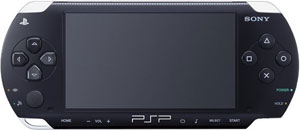PlayStation Portable

The PlayStation Portable (officially PSP), a handheld game console, is a product of Sony Computer Entertainment. The PSP was first announced in 2003 and was unveiled in 2004. It features wireless networking capabilities.
The PSP is capable of displaying still image, movie, and audio files stored on the UMD disk format or a memory stick. The system supports MP3 and Sony's ATRAC3 plus formats for audio, MPEG-4 for video on UMD discs, and JPEG images. Unlike UMD movies, resolution of movies on a memory stick is limited to 76,800 pixels (320x240, 368x208, 480x160, etc.), resulting in lower quality movies than UMD movies.
Sony has announced that Image Converter 2, a piece of PC software for converting video files to AVC for playback on CLIÉ PDAs, will be available before the end of the year, and may be used with the PSP. A preview version was made available shortly after the PSP launch. It can convert *.avi, MPEG1/2/4, QuickTime and *.wmv movie files to AVC, as well as the "Giga Pocket" and "Do VAIO" files used by VAIO PCs to record television. It will also convert most common still image files into JPEG format. Sony's SonicStage software can be used to copy *.mp3 and ATRAC files to the PSP as well.
Sony's software is not the only toolset for getting music or movies onto a PSP. A cottage industry has grown around offering useful tools for converting and copying files for use on the PSP. Some popular alternatives include Media Boss, PSP Movie Creator, PSP Video Express, Xcopy9, PSPWare, iPSP, Mobile Media Maker, PSP Video 9, 3GP Converter and PSP Multimedia Extender all simplify the task of converting and transferring files to and from the PSP's Memory Stick. Additionally, some FOSS programs, such as FFmpeg can be used to convert video into a properly sized and formatted PSP video file. Using these tools, nearly any digital video file (including movie files ripped from DVDs or digital video recorders like the TiVo) can be played on a PSP, after conversion to AVC.
Video file sizes largely depend on the audio and video bit rates. With reasonable settings (a resolution of 320x240, a video bit rate of 500 Kilobits per second, and an audio sampling rate of 22050 kHz) a 22 minute movie file is roughly 55 megabytes. (This is enough for a 30 minute television episode with the commercials removed) This means that a 512 MB Memory Stick can hold approximately nine of these files. A hundred-minute feature film can fit on a 256 MB Memory Stick.
Many movie files, both free-to-distribute and pirated, have been encoded for the PSP and are available on the internet. Game and movie trailers, in particular, are increasingly available, even from the studio's official site.
Sony released firmware update version 2.0 on July 27, 2005 in Japan and on August 24, 2005 in North America. It was also packaged in the retail product for European and Australian PSPs. The firmware upgrade added the ability to play MP4 AAC audio files, ATRAC3plus audio files from a Memory Stick Pro Duo, MPEG-4 AVC video files (if encoded using a proprietary Sony encoding), as well as view GIF, Bitmap (BMP), and TIF image files. It also added the ability to send photos wirelessly to another PSP system and allowed owners to use an image as background wallpaper. It also added support for WPA-PSK wireless encryption.
On October 3, 2005, firmware version 2.01 was released. This upgrade fixed the image overload buffer problem that allowed the PSP to be "downgraded" via a homebrew hack. After the 2.01 firmware version SONY released the new 2.50. Speculation states 2.50 was launched to attract users to upgrade: blocking any possible means of homebrew. It also included the LocationFree Player. If owners own a LocationFree Base Station at home, they can play streaming movies, over the Internet, from anywhere in the world, on their PSP. Also added were the Korean character set, the ability to play copyrighted movies, form history on the web browser, and time and date synchronization via the internet. Recently the 2.60 update has been released, the main features include streaming of podcast audio directly from the web using an RSS feed; and also playback of the WMA audio format (this requires online activation). Although the update was supposed to fix all possible holes in the programming of the system, a bug, found in the game Grand Theft Auto: Liberty City Stories, has seemed to open the door for homebrew once again.
The PSP's major rival, the Nintendo DS, is considered to be in the same market as the PlayStation Portable (though representatives from both companies have stated that each system targets a different audience).
